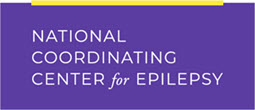The National Coordinating Center for Epilepsy has developed the Strengthen & Enhance Epilepsy Knowledge (SEEK) Training as a resource to help build capacity and start conversations amongst medical residents, school nurses, social workers, community health workers, and public health professionals regarding the care of children and youth with epilepsy. This training is intended to be self-guided or facilitated as a Lunch and Learn opportunity to encourage discussion in a short 30-minute presentation. This training consists of a pre-recorded didactic lecture presentation, presenter slides, and a case study for the facilitator.
Facilitated Lunch and Learn - Strengthen & Enhance Epilepsy Knowledge (SEEK) Training
Instructions: The stories below present various examples of the complexities and nuances associated with various epileptic syndromes, from the perspective of a pediatric clinician/medical home. It is recommended that these stories be presented and discussed during the Lunch and Learn series. Refer to the module slides to help guide the discussion.
Please discuss the following scenarios for pediatric patients with epilepsy and/or seizures. For each patient, provide a recommendation for a seizure rescue medication and a seizure action plan.
- A 6-year-old girl with Lennox Gastaut syndrome (multiple daily seizures and intellectual disability) has a 10-minute seizure at school once per week for which an ambulance is called and she is taken to the ER. She weighs 45 kg.
- A 12-month-old boy has a cluster of febrile seizures when sick. Currently, his parents are uninsured and have concerns about being able to afford proper care and medications. He weighs 10 kg.
- 3. A 15-year-old girl with focal seizures wants to go to her friend’s house for a sleepover but has had prolonged seizures in the past and her parents don’t feel it’s safe. Her seizures consist of a premonitory aura of right facial numbness that progresses to right-sided body twitching and then to a bilateral tonic-clonic seizure. She weighs 55 kg.
Case study Questions & Answers
Use the questions below to guide conversation following the story. Possible answers are bulleted below each question. The responses are by no means exhaustive.
1) What seizure rescue medication formulation and dose would be most appropriate for the 6-year-old girl with Lennox Gastaut syndrome?
Suggested Answers:
a) Intranasal diazepam 10 mg. This could be administered for seizures lasting longer than 5 minutes or clusters of seizures (more than a few in an hour since she has daily seizures at baseline).
b) She should receive intranasal diazepam at her weight-based dose, which is roughly 10 mg.
c) Rectal diazepam can also be administered at 0.3 mg/kg, again around 10 mg, but considering the seizures occur at school, intranasal diazepam is preferred to reduce embarrassment and allow for ease of access by faculty and staff.
d) She is too young to receive intranasal midazolam.
e) Ideally this would prevent an ambulance trip to the ER which is disruptive and expensive, though schools and facilities will often call 911 regardless to have the patient evaluated.
f) A Seizure Action Plan is needed to guide decisions about administering rescue medications and calling 911 while at school; reduces frantic calls to parents or authorities.
g) For any child with Lennox Gastaut syndrome or other intractable epilepsies with frequent seizures, a seizure action plan should detail the different seizure types including a description of what the child does. Some seizures may need rescue (such as a 10-minute generalized tonic clonic convulsion) but others do not need to be treated urgently (brief myoclonic jerks or absence seizures).
2) What seizure rescue medication formulation and dose would be most appropriate for the 12-month-old boy with clusters of febrile seizures when sick?
Suggested Answers:
a) Rectal diazepam 5 mg. Although rectal diazepam is only approved for children older than 2 years, it is often used in children older than 6 months. Children with febrile seizures often have seizures at the beginning of the illness. While rescue treatment is not necessarily needed for a single brief febrile seizure if the patient has prolonged (> 5 minutes) or repetitive febrile seizures a rescue medication is indicated.
b) Another option to consider would be an oral clonazepam bridge during periods of illness.
3) What seizure rescue medication formulation and dose would be most appropriate for the 15-year-old girl with prolonged focal seizures who wants to go on a sleepover? Should the patient disclose to her friend and their parents that she has epilepsy?
Suggested Answers:
a) Intranasal midazolam 5mg or intranasal diazepam 15mg (which comes as a set of 2 7.5mg doses). Alternatively, because the patient has a premonitory phase (aura) if she is aware enough during this period, she could take an oral abortive agent such as clonazepam.
b) Bringing a seizure rescue medication to a sleepover likely necessitates disclosing the diagnosis of epilepsy to the friend and their parents. Whether or not and to whom to disclose a diagnosis is patient specific and requires ongoing conversation between the child or adolescent, their caregivers, and their physician.
i) Can also depend on who is at the sleepover or its size.
ii) Make sure she takes her regular medication before attending to prevent a breakthrough seizure.
c) Rectal medications are not preferred since she can receive intranasal.
If you have any questions regarding epilepsy orthisfacilitated minitraining, please contact: The National Coordinating Center for Epilepsy
This project is supported by the Health Resources and Services Administration (HRSA) of the U.S. Department of Health and Human Services (HHS) under grant number U23MC26252, Awareness and Access to Care for Children and Youth with Epilepsy cooperative agreement. This information or content and conclusions are those of the author and should not be construed as the official position or policy of, nor should any endorsements be inferred by HRSA, HHS, or the U.S. Government.
Last Updated
08/28/2023
Source
American Academy of Pediatrics
